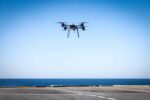Teledyne FLIR Defense and AimLock have partnered to integrate advanced precision fire control technology into the SkyRanger R70 unmanned aerial system (UAS), aiming to deliver a more effective solution for counter-unmanned aircraft systems (C-UAS) operations. This collaboration represents a significant step in merging AI-driven targeting with mobile ISR platforms to neutralize small drones in complex environments.
Integration Overview: AimLock + SkyRanger R70
The new capability stems from the integration of AimLock’s precision fire control system onto Teledyne FLIR’s SkyRanger R70 UAS. The combined system allows for autonomous or semi-autonomous detection, tracking, and engagement of aerial threats—particularly Group 1 and Group 2 drones. The demonstration of this integrated solution occurred at the U.S. Army’s annual Maneuver and Fires Integration Experiment (MFIX) at Fort Sill in April 2024.
AimLock’s technology enables real-time ballistic computation and target lead prediction using onboard sensors and AI algorithms. When mounted on a stabilized weapon platform—such as a manned or unmanned turret—the system can maintain precise aim on fast-moving or erratic targets without manual corrections by the operator. In this integration, the SkyRanger serves as both an ISR asset and targeting node, feeding data into AimLock-enabled weapon stations or kinetic interceptors.
System Capabilities and Operational Use Cases
The integrated solution is designed to address growing threats posed by low-cost commercial drones used in reconnaissance or loitering munition roles. Key capabilities include:
- Autonomous Target Tracking: Using EO/IR sensors on the SkyRanger R70 combined with AimLock’s software-defined targeting engine.
- Precision Engagement: Fire control algorithms compute lead angles and movement vectors in real time for kinetic interceptors.
- Modular Deployment: The system can be mounted on tripods, vehicles, robotic platforms (UGVs), or static emplacements for flexible mission profiles.
This modularity is critical for expeditionary forces operating in urban or contested environments where drone swarms may appear unpredictably. By leveraging airborne ISR assets like the R70 to cue ground-based weapons equipped with AimLock modules, operators can reduce sensor-to-shooter latency while improving hit probability against agile airborne targets.
AimLock Technology Background
AimLock was founded in Colorado Springs with a focus on applying machine vision and AI to improve marksmanship at both individual soldier and crew-served weapon levels. Its core product is a precision fire control module that includes inertial measurement units (IMUs), optical sensors, onboard computing hardware, and software that corrects for motion-induced deviation during aiming.
The system has been tested on various platforms including M240 machine guns, M134 miniguns mounted on vehicles or helicopters, as well as robotic weapon stations like those used on UGVs. In all cases, AimLock reduces operator burden by automating ballistic calculations based on range-to-target estimates derived from onboard optics or external rangefinders.
Teledyne FLIR’s Role in C-UAS Ecosystem
Teledyne FLIR Defense has positioned itself as a key provider of tactical UAS platforms such as the SkyRanger series (including the R60 successor) along with multi-sensor payloads optimized for surveillance and targeting. The company has also developed fixed-site C-UAS systems like Black Hornet Nano UAVs for short-range reconnaissance and thermal imaging payloads for perimeter defense solutions.
The addition of kinetic effectors guided by airborne ISR assets marks an evolution from passive detection to active interdiction within Teledyne’s portfolio. By incorporating third-party fire control solutions like AimLock into their ecosystem—via open architecture standards—the company enhances its relevance amid rising demand for layered drone defense systems across NATO militaries.
Implications for Future Counter-Drone Doctrine
The integration reflects broader shifts in counter-drone doctrine toward distributed sensing and decentralized engagement models. Instead of relying solely on radar-based detection followed by centralized command decisions—often too slow against FPV drones—this approach empowers edge nodes (e.g., small UAVs) to detect threats early and cue local shooters autonomously.
This aligns with emerging U.S. Army concepts such as “Mosaic Warfare” where diverse sensors communicate via mesh networks to enable faster kill chains. The combination of lightweight tactical drones like the SkyRanger with embedded AI-driven fire control could enable platoon-level units to defend themselves against drone incursions without waiting for higher-echelon support.
Challenges Ahead: ROE Compliance & Blue Force Deconfliction
While promising from a technological standpoint, deploying autonomous or semi-autonomous kinetic engagement systems raises questions about rules of engagement (ROE), fratricide risk, electronic interference resilience, and identification friend-or-foe (IFF) integration. Ensuring that such systems do not misidentify friendly assets—or engage civilian drones inadvertently—will require robust safeguards including human-in-the-loop overrides where feasible.
AimLock has stated that its systems are designed with configurable autonomy levels ranging from full manual override to supervised autonomy depending on mission parameters set by commanders. However, widespread fielding will likely depend on successful operational testing under realistic battlefield conditions—including GPS-denied environments where sensor fusion becomes critical due to degraded navigation inputs.
Outlook: Toward Networked Kill Web Architectures
The collaboration between AimLock and Teledyne FLIR fits within broader trends toward networked C-UAS architectures combining electro-optical tracking, RF detection/jamming modules (e.g., DroneShield), directed energy weapons (e.g., HELWS), loitering munitions interception (e.g., Switchblade), and kinetic hard-kill options guided by AI-enhanced fire control modules like AimLock’s offering.
If successfully matured beyond demonstrations like MFIX 2024 into fielded programs-of-record within DoD or allied procurement pipelines—this type of modular kill web could dramatically improve force protection at forward operating bases (FOBs), mobile convoys, critical infrastructure sites, or even naval vessels vulnerable to low-flying drone threats near coastlines or straits.









